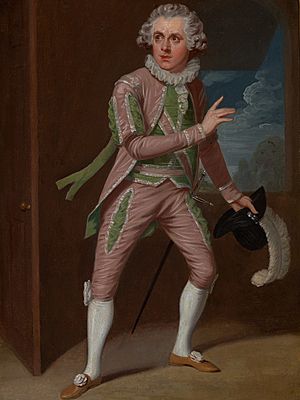William Wyatt Dimond facts for kids
William Wyatt Dimond (born 1750, died 1812) was a famous actor and theatre manager. He lived in the late 1700s and early 1800s. Most of his career was spent in the city of Bath, located in Somerset, England.
Contents
William Dimond's Early Acting Days
Some stories about William Dimond's early life might not be completely true. It was said he was born in London. His father supposedly died young, and his mother remarried a naval officer. He was also said to have gone to Richmond Grammar School until he was 15.
The story goes that he then joined the British Army. But his mother didn't want him to go to the West Indies with his army group. So, she convinced him to leave the army. Dimond then became an apprentice in a craft called chasing. This is where you decorate metal.
However, William Dimond really wanted to be an actor. He was known for his good manners and friendly personality. These traits made him seem like a gentleman. He decided to try acting on stage.
His first known acting job was a secret one. He was called 'A Young Gentleman' and said he was 19. He played Romeo in Romeo and Juliet on October 1, 1772. This was at the Theatre Royal, Drury Lane in London. He acted opposite Miss Mansell, who played Juliet.
He appeared again as 'A Young Gentleman' in January 1773. He played Dorilas in Mérope. In May 1773, he played Moneses in Tamerlane. A theatre worker wrote that Dimond was "very young" with a "good Voice." He made a "very tolerable first appearance" and got "great applause." He stayed at Drury Lane for that season but only acted five more times.
In the summer of 1773, Dimond helped manage a theatre in Canterbury. He then returned to Drury Lane. He played smaller roles in Garrick's acting group. Some of his roles included Rovewell in The Fair Quaker and The Dauphin in King John. In May 1774, he played Florizel in Florizel and Perdita. This play was based on Shakespeare's The Winter's Tale.
Moving to Bath and Becoming a Star
When Dimond first visited the Theatre Royal, Bath in 1774, he probably didn't know how important it would become for him. He would be connected to Bath for the next 30 years. He returned to Bath in October 1774. He played a small part in Richard III at the Old Orchard Street Theatre.
Bath was a very popular spa town at this time. Many important visitors came there. The Orchard Street theatre was too small for everyone who wanted to see shows. So, its managers made it twice as big.
When Dimond came back for the 1775–76 season, he finally got the main roles he wanted. This was especially true after another actor, John Henderson, moved to London in 1777. From 1779 to 1782, Dimond acted with the famous Sarah Siddons. He played Jaffier to her Belvidera in Venice Preserv'd. He was also Bassanio to her Portia in The Merchant of Venice.
Dimond was very good in funny plays about society. These plays let him wear fancy costumes. They showed off his graceful movements. The writer Sheridan thought Dimond's acting in The School for Scandal was exactly what he imagined. Dimond also kept playing serious, sad roles. He played Romeo in 1790 and Hamlet in both Bath and Bristol.
Before he stopped acting, a newspaper praised his skills in funny roles. But it said his serious roles were too perfect. It wrote that "nothing is irregular, nothing is left to chance." This meant his acting was very neat and controlled.
Life in Bath and Theatre Management
Dimond lived in Bath. On December 2, 1779, he married Matilda Martha Baker in London. She was from Norfolk and had her own money. They had three children who grew up in Bath. Their oldest son, William Dimond, became a writer of plays and a theatre manager.
William Wyatt Dimond got the chance to manage the theatre in Bath in 1786. This happened because John Palmer was busy. Palmer owned the Theatre Royal in Bristol, too. The two theatres shared one acting group. Palmer needed to move actors, stagehands, and props quickly between Bristol and Bath. So, he started a coach service. This service helped his theatre work run smoothly.
Later, Palmer became involved with the Post Office. He realized his coach service could be used to deliver mail across the country. He managed the theatre until 1785. Then he became a high-ranking official at the Post Office. He gave control of the theatre to two people already working there: William Keasberry and Dimond. As a theatre manager, Dimond was very liked by everyone. This included the theatre directors, the public, and the actors.
Later Years and Legacy
Dimond gave his last acting performance in Bristol on July 1, 1801. He played Edgar in The History of King Lear. But he continued to manage theatres until he died. He had a 17-year agreement to run the Old Orchard Street Theatre starting in 1799.
Perhaps his biggest success was building the Theatre Royal, Bath. It opened on October 12, 1805. Dimond was very good at convincing famous actors from London to come to Bath. These included Sarah Siddons on her last tour in 1811, Dorothea Jordan, and Charles Kemble.
At the peak of his success as a manager, Dimond had a stroke on December 24, 1811. He passed away at his home in Norfolk Crescent on January 2, 1812. He was buried in Bath Abbey. In his will, he left his property and theatre business to his wife. After she died in 1823, their son William Dimond took over managing the Theatre Royal, Bath.
Images for kids







